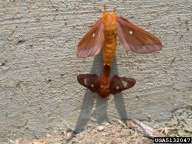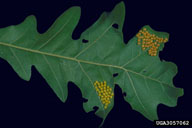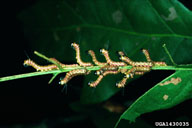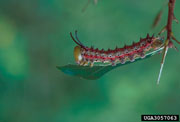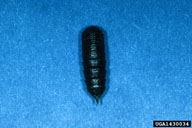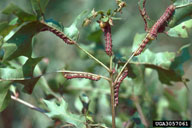Pinkstriped oakworm
Anisota virginiensis (Drury) (Lepidoptera: Saturniidae)
Orientation to pest
Pinkstriped oakworm, Anisota virginiensis (Drury), is a native moth that feeds on foliage of oaks (Quercus) and other hardwoods. It occurs throughout the eastern United States and southern Canada. Young larvae feed in groups, skeltonizing leaves. Older larvae are less gregarious and consume all but the main veins of leaves. Larvae can be found April through September depending on the climate, with one generation per year in its northern range and up to three generations per year in its southern-most range. This insect is common but not abundant and is usually considered a minor pest to landscape trees where damage to larger trees is often limited to defoliation of single branches. However, small trees can be completely defoliated.
Hosts commonly attacked
Pinkstriped oakworm feeds primarily on oaks (Quercus), but it is also reported from chestnut (Castanea), hazel (Corylus), maple (Acer) and birch (Betula).
Distribution
This species occurs in southern Canada and the eastern United States, as far west as Manitoba and Texas.
Images of pinkstriped oakworm
| Figure 1. Adults of pinkstriped oakworm, Anisota virginiensis: male and female mating | Figure 2. Eggs of pinkstriped oakworm | Figure 3. Young larvae of pinkstriped oakworm |
| Figure 4. Close up of pinkstriped oakworm larva | Figure 5. Pupa of pinkstriped oakworm | Figure 6. A group of pinkstriped oakworm caterpillars defoliating an oak branch |
Important biological control agents related to this pest species
In Manitoba, five species of larval or pupal parasitoids have been recorded from this species: Houghia sternalis (Coquillett), Lespesia anisotae Webber, and Winthemia datanae (Tns.) (all Tachinidae); and Habronyx magniceps (Cresson) and Hyposoter fugitivus (Say) (both Ichneumonidae).
Web links for information on pinkstriped oakworm
- Guide for Species Recognition and Habits | L.L. Hyche, Auburn University
- Orangestriped Oakworm, Pinkstriped Oakworm, and Spiny Oakworm | USDA Forest Service, FHP Southern Region
Provides information about identification of insect and injury, biology, and control of several species - "What's Chewing my Oak Tree?" | University of Florida IFAS Extension
Fact sheet including photos and information on cultural management and pesticides
Articles
- Wagner, D. L., V. Giles, R.C. Reardon, and M. L. McManus. 1998. Caterpillars of Eastern Forests. USFS Technology Transfer Bulletin, FHTET-96-34. 113 pp.
- Henne, D. C. 2004. Parasitoid survey of Anisota virginiensis (Lepidoptera: Saturniidae) at Belair, Manitoba from 1989-1999. Proceedings of the Entomological Society of Manitoba 60: 5-10.
